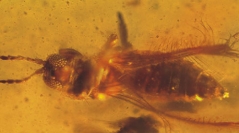

 Comptes Rendus Palevol
6 (1-2) - Pages 135-149
Comptes Rendus Palevol
6 (1-2) - Pages 135-149Amber-bearing deposits are a specific kind of fossil bioaccumulation that preserves exceptionally well palaeobiological information from the past. The present article discusses the ‘state of the art’ of the knowledge of certain Spanish amber-bearing deposits from the Cretaceous (Albian-Cenomanian). A bibliographic compilation of previous studies, together with new discoveries, shows the existence of over 100 amber localities; nevertheless, only in seven of these have arthropod inclusions been found. The sites are Albian in age, associated with coal deposited on deltaic environments. These outcrops are distributed in a strip curve through the North to the East of the Iberian Peninsula and which corresponds to the coastal line during the Early Cretaceous. It includes (from the northwest to the east): the Central Asturian Depression, the Basque-Cantabrian Basin, and the Maestrat Basin, respectively. Infrared spectroscopy (IRTF) analyses show close similarities between all these amber localities. Gas chromatography–mass spectrometry (GC–MS) of the Álava amber suggests that Agathis (Coniferales: Araucariaceae) or another closely related group of conifers was one of the resin producer trees of Spanish ambers. Numerous new records and taxa occur in the botanical source for Spanish Cretaceous amber; additional material has been newly excavated in the Moraza-Peñacerrada, Arroyo de la Pascueta, La Hoya, and San Just outcrops. More than two thousand inclusions are found in the Moraza-Peñacerrada sites (Burgos and Álava Provinces). In all the amber outcrops, the dominant group is composed by arthropods, and among them hexapods, with 17 orders being recognized to date. The most abundant and diverse insect groups are dipterans, hymenopterans and coleopterans, mainly parasitoid, saproxylic or herbivorous forms.
Amber, Lower Cretaceous, sedimentary environments, geochemistry, palaeobiology, Spain